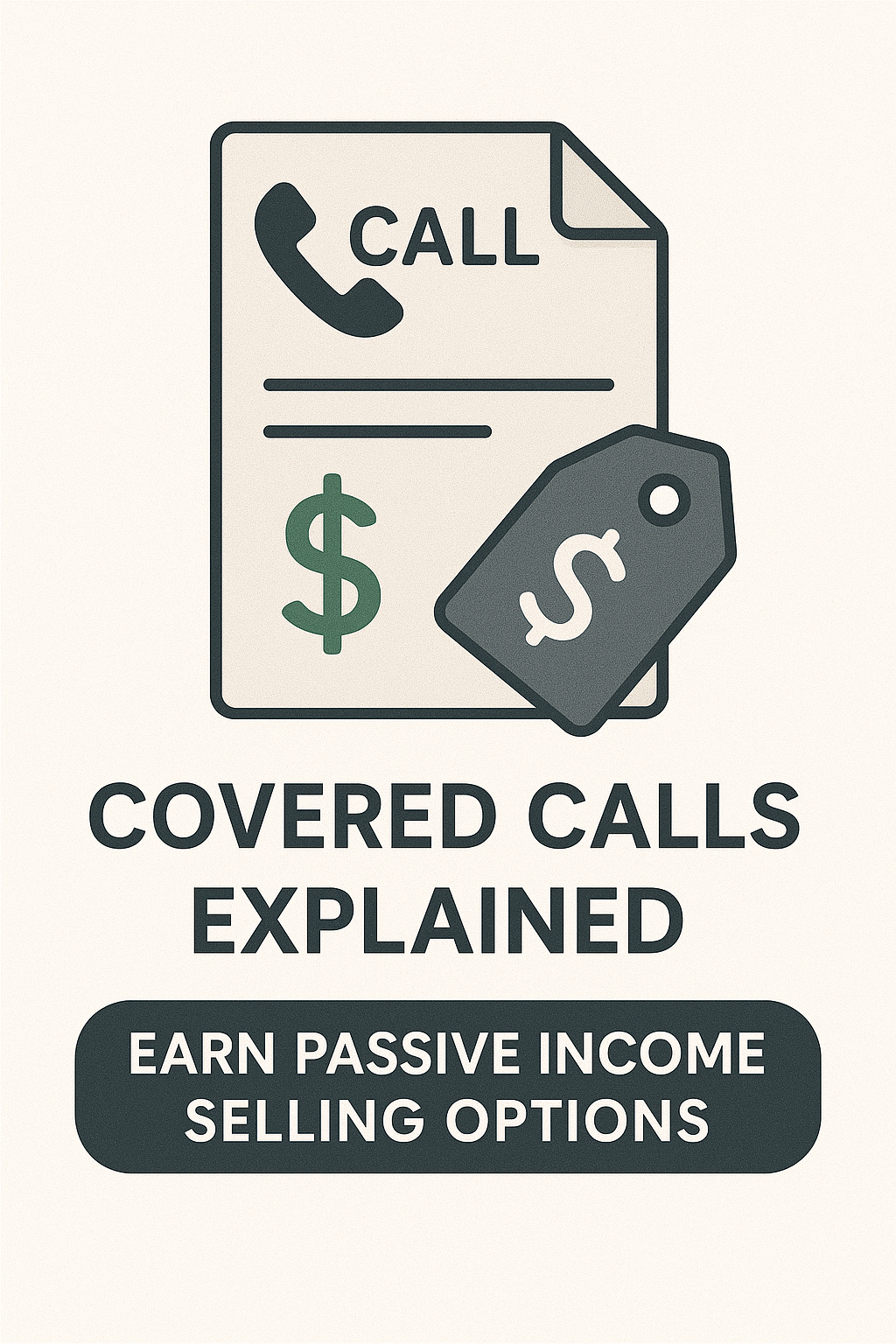Covered Calls: A Strategy for Income Generation
Covered calls are a cornerstone strategy in the realm of options trading, offering investors a unique avenue for generating income on their existing stock holdings. This approach involves selling call options on shares you already own, effectively granting someone else the right, but not the obligation, to purchase those shares at a specific price within a specific timeframe. In return for this right, you, as the seller, receive a premium.
This strategy is particularly favored by investors seeking to enhance their portfolio’s returns without necessarily relinquishing ownership of their stock. It’s a nuanced approach that balances income generation with potential opportunity cost. This comprehensive guide aims to delve into the intricacies of covered calls, providing a detailed exploration of their mechanics, advantages, potential risks, strategic implementations, and tax considerations. Whether you’re a seasoned investor or new to the world of options, understanding covered calls can empower you to make more informed decisions and potentially optimize your investment strategy.
Understanding Options: The Foundation of Covered Calls
Before we can effectively discuss covered calls, it’s crucial to lay a solid foundation by understanding the fundamental building blocks: options themselves. An option is, at its core, a contract. This contract gives the buyer the right, but not the obligation, to either buy (in the case of a call option) or sell (in the case of a put option) an underlying asset at a predetermined price on or before a specified date.
The Two Faces of an Option Contract
Every option contract involves two key players:
- The Buyer (Holder): This is the party who purchases the option contract. They pay a premium for the rights the contract confers.
- The Seller (Writer): This is the party who sells the option contract. In exchange for the premium, they assume certain obligations.
Key Terms in Options Trading
To navigate the world of options, you’ll need to familiarize yourself with some essential terminology:
- Premium: This is the price that the buyer of the option pays to the seller for the option contract. It’s the cost of acquiring the rights granted by the option.
- Strike Price: The strike price is the predetermined price at which the underlying asset can be bought or sold if the option is exercised.
- Expiration Date: This is the date on or before which the option can be exercised. After this date, the option contract is void.
- Underlying Asset: This is the asset upon which the option contract is based. It could be a stock, a commodity, a currency, or another financial instrument.
- Call Option: A call option grants the buyer the right to buy the underlying asset at the strike price.
- Put Option: A put option grants the buyer the right to sell the underlying asset at the strike price.
Option Moneyness: Understanding Intrinsic Value
Another critical concept in options trading is “moneyness.” This term describes the relationship between the strike price of an option and the current market price of the underlying asset. It helps determine whether an option has intrinsic value.
- In the Money (ITM):
- For a call option, ITM means the underlying asset’s current market price is above the strike price.
- For a put option, ITM means the underlying asset’s current market price is below the strike price.
- ITM options have intrinsic value, which is the amount of profit that could be realized if the option were exercised immediately.
- At the Money (ATM):
- An option is ATM when the underlying asset’s current market price is equal to the strike price.
- ATM options have no intrinsic value, but they may have time value.
- Out of the Money (OTM):
- For a call option, OTM means the underlying asset’s current market price is below the strike price.
- For a put option, OTM means the underlying asset’s current market price is above the strike price.
- OTM options have no intrinsic value; their value is derived solely from time value and the potential for the underlying asset’s price to move favorably before expiration.
Covered Calls: A Detailed Definition
With a solid understanding of options in place, we can now turn our attention to the heart of our discussion: covered calls.
What Exactly is a Covered Call?
At its core, a covered call strategy involves two simultaneous actions:
- Owning the Underlying Stock: You must already own shares of the stock on which you plan to sell the option.
- Selling a Call Option: You sell a call option on those same shares.
By owning the underlying stock, you are “covering” your obligation. This means that if the option buyer exercises their right to buy your shares, you already possess those shares and can deliver them. This is what distinguishes a covered call from a “naked” call, where the seller does not own the underlying stock and faces potentially unlimited risk.
A Practical Example
Let’s illustrate this with an example:
- You own 100 shares of XYZ Corporation stock.
- You sell one call option on XYZ stock with a strike price of $50 and an expiration date in one month.
- You receive a premium of $5 per share, resulting in a total premium of $500 (100 shares x $5).
In this example:
- If, at the end of the one-month period, XYZ stock is trading at or below $50, the option buyer will likely choose not to exercise their option. You keep the $500 premium, and you still own your 100 shares of XYZ stock.
- If, at the end of the one-month period, XYZ stock is trading above $50, the option buyer will likely exercise their option. You are then obligated to sell your 100 shares of XYZ stock at $50 per share. You receive $5000 for your shares (100 shares x $50), and you also retain the $500 premium.
The Mechanics of a Covered Call: A Step-by-Step Breakdown
To further solidify your understanding, let’s walk through a step-by-step example of how a covered call strategy unfolds:
- Acquire the Underlying Stock: You begin by purchasing 100 shares of ABC stock at $40 per share, for a total investment of $4,000.
- Sell the Call Option: You then sell one call option on ABC stock with a strike price of $45 and an expiration date 30 days in the future. In exchange, you receive a premium of $3 per share, or $300 in total.
- Potential Outcomes at Expiration: The outcome of your covered call position will depend on the price of ABC stock at the end of the 30-day period. There are three primary scenarios:
- Scenario 1: Stock Price Remains at or Below the Strike Price ($45): If ABC stock is trading at or below $45 at expiration, the option buyer will most likely not exercise the option.
- You keep the $300 premium.
- You retain ownership of your 100 shares of ABC stock.
- Your total profit in this scenario is $300.
- Scenario 2: Stock Price Rises Above the Strike Price ($45) But Remains Below Stock Price Appreciation + Premium Income: If ABC stock is trading above $45, the option buyer may exercise the option. For example, if the stock price is $48, you sell your shares for $45.
- You are obligated to sell your 100 shares of ABC stock at $45 per share.
- You receive $4,500 for your shares (100 shares x $45).
- You also keep the $300 premium.
- Your total profit is $800 ($4500 sale – $4000 initial investment + $300 premium income)
- Scenario 3: Stock Price Rises Significantly Above the Strike Price ($45): If ABC stock rises substantially above $45, for instance, reaching $55, the option buyer will almost certainly exercise the option.
- You are still obligated to sell your 100 shares of ABC stock at $45 per share.
- You receive $4,500 for your shares (100 shares x $45).
- You still keep the $300 premium.
- Your total profit remains capped at $800. You do not benefit from the stock’s price increase beyond the strike price of $45. This limitation illustrates the capped profit potential that is a defining characteristic of the covered call strategy.
- Scenario 1: Stock Price Remains at or Below the Strike Price ($45): If ABC stock is trading at or below $45 at expiration, the option buyer will most likely not exercise the option.
The Allure of Covered Calls: Exploring the Benefits
Covered calls are a popular strategy for a reason. They offer several potential advantages for investors:
- Income Generation: The most prominent advantage of covered calls is their ability to generate income. By selling call options, investors receive a premium. This premium can supplement returns from dividends or capital appreciation. In markets that are relatively flat or experiencing only modest growth, this income stream can be particularly valuable.
- Partial Downside Protection: While it’s crucial to emphasize that covered calls do not provide complete protection against losses, the premium received from selling the call options can act as a partial cushion against a decline in the stock price. If the stock price falls, the premium income can help offset some of those losses.
- Enhanced Returns in Flat Markets: Covered calls can be particularly effective in enhancing returns in markets where the underlying stock price remains relatively stable. In such conditions, the investor collects the premium, and the option is less likely to be exercised, allowing the investor to retain their stock while generating income.
- Strategy Flexibility: Covered calls are not a one-size-fits-all strategy. They can be tailored to align with a variety of investment objectives and risk tolerances. Investors have the flexibility to choose strike prices and expiration dates that best suit their specific financial goals and market outlook.
Navigating the Challenges: Understanding the Risks
Like any investment strategy, covered calls are not without their risks. It’s essential to be aware of these potential downsides before implementing this approach:
- Capped Profit Potential: One of the most significant limitations of covered calls is their capped profit potential. The maximum profit that can be achieved is typically the sum of the strike price and the premium received. Consequently, if the stock price rises substantially above the strike price, the investor is obligated to sell their shares at the strike price, thereby forgoing any potential gains beyond that level.
- Limited Upside Participation: Closely related to the capped profit potential is the limited upside participation. Covered calls inherently limit an investor’s ability to participate in significant stock price appreciation. If the stock price experiences a dramatic upward surge, the investor will likely be required to sell their shares at the strike price, missing out on the full extent of the stock’s gains.
- Downside Risk: It’s imperative to understand that covered calls do not offer protection against substantial stock price declines. If the stock price falls, the investor still owns the stock and will incur losses. The premium received from selling the call option provides only a partial offset to these losses, not complete protection.
- Opportunity Cost: There’s also the element of opportunity cost. If the stock price rises sharply, the investor may experience regret, feeling they missed out on a more lucrative opportunity by selling the call option.
- Early Assignment Risk: Although less common, the risk of early assignment exists. This means the option buyer could choose to exercise the option before the expiration date. Should this occur, the investor would be obligated to sell their shares at the strike price, potentially earlier than initially anticipated.
- Tax Implications: The tax implications of covered calls can add another layer of complexity. The premiums received from selling call options are considered taxable income. Furthermore, if the shares are sold upon exercise, this triggers a taxable event, potentially resulting in capital gains taxes.
Fine-Tuning Your Approach: Covered Call Strategies
The covered call strategy is not monolithic; it offers several variations, each with its own distinct risk and reward profile. Here are some of the most common approaches:
- At-the-Money (ATM) Covered Calls: This strategy involves selling call options with a strike price that is either the same as or very close to the current market price of the underlying stock.
- Characteristics: This approach typically generates a higher premium for the seller but also carries a moderate probability that the option will be exercised.
- Ideal for: Investors who are primarily seeking to maximize their income generation and who have a neutral outlook on the stock’s short-term price movement.
- In-the-Money (ITM) Covered Calls: In this variation, you sell call options with a strike price that is below the current market price of the underlying stock.
- Characteristics: This strategy generates the highest premium income but also carries a high probability that the option will be exercised.
- Ideal for: Investors who are willing to part with their shares at a price slightly higher than the current market price and who are primarily focused on maximizing income.
- Out-of-the-Money (OTM) Covered Calls: This involves selling call options with a strike price that is above the current market price of the underlying stock.
- Characteristics: This approach generates a lower premium but also has a lower probability that the option will be exercised.
- Ideal for: Investors who wish to generate some income but are generally bullish on the stock’s price and prefer to retain ownership of their shares.
Making Informed Decisions: Factors to Consider
Successfully implementing a covered call strategy requires careful consideration of several key factors:
- Investment Objective: Are you primarily seeking to generate income, or is your focus on capital appreciation?
- Risk Tolerance: How much of the potential upside are you willing to sacrifice in exchange for the income generated by selling call options?
- Time Horizon: How long do you intend to hold the underlying stock?
- Stock Outlook: What are your expectations regarding the future price movement of the stock?
- Strike Price Selection: Where do you anticipate the stock price to be at the option’s expiration date?
- Expiration Date Selection: How much time are you willing to give the option buyer to potentially exercise their option?
- Premium Amount: How much income will you receive for selling the option contract?
- Underlying Asset Volatility: Highly volatile stocks generally offer higher premiums, making them attractive to covered call sellers, but they also carry a greater risk of significant price fluctuations, which could lead to the option being exercised.
A Comparative Perspective: Covered Calls vs. Other Options Strategies
Covered calls represent just one facet of the vast world of options trading. To gain a broader perspective, let’s briefly compare them to some other commonly employed options strategies:
- Covered Call vs. Long Call: A covered call involves selling a call option on stock you already own, while a long call involves buying a call option. A long call is a bullish strategy that offers limited risk and unlimited potential profit, but it requires an upfront investment (the premium paid).
- Covered Call vs. Protective Put: A covered call is used to generate income on stock you own, whereas a protective put involves buying a put option on stock you own to protect against potential downside risk. A protective put is a bearish strategy that limits potential losses but also entails an upfront investment (the premium paid).
- Covered Call vs. Naked Call: A covered call is considered a “covered” strategy because you own the underlying stock. In contrast, a naked call involves selling a call option without owning the underlying stock. Naked calls carry the potential for unlimited losses and are generally considered a high-risk strategy.
Tax Considerations: Navigating the Tax Implications
The tax implications of covered calls can be a complex area, and it’s essential to be aware of the potential consequences:
- Premium Income: The premium you receive from selling a call option is considered taxable income in the year in which you receive it.
- Sale of Shares: If the option is exercised, and you are required to sell your shares, this constitutes a taxable event. The tax treatment of this sale will depend on your holding period for the shares:
- Short-term capital gain/loss: If you held the shares for one year or less.
- Long-term capital gain/loss: If you held the shares for more than one year.
- Option Expiration: If the option expires unexercised, you simply retain the premium, which is taxed as ordinary income.
Important Note: The information provided here is for general knowledge only and should not be construed as tax advice. Tax laws are subject to change, and individual circumstances can vary significantly. It is strongly recommended that you consult with a qualified tax professional for personalized advice tailored to your specific situation.
Is a Covered Call the Right Fit for You?
Covered calls can be a valuable tool for investors seeking to generate income from their existing stock holdings. However, they are not universally suitable for all investors. Consider the following factors to help you determine if a covered call strategy aligns with your investment goals and risk tolerance:
- Your Willingness to Sell Your Stock: A fundamental aspect of the covered call strategy is the possibility that you may have to sell your stock. If you have a very bullish outlook on a particular stock and intend to hold it for an extended period, covered calls may not be the optimal strategy, as you could be required to sell your shares if the option is exercised.
- Your Comfort Level with Limited Upside Potential: Covered calls inherently cap your potential profits. If your primary investment objective is to achieve substantial capital appreciation, this strategy may not be ideal, as it limits your ability to participate in significant upward price movements.
- Your Desire to Generate Income: If your primary investment goal is to generate a consistent income stream from your investments, covered calls can be an effective means of achieving this objective.
- Your Market Outlook: Covered calls tend to perform best when you have a neutral to moderately bullish outlook on the stock’s price. They are well-suited for situations where you anticipate the stock price will remain relatively flat, experience moderate growth, or trade within a defined range during the option’s duration.
A Detailed Example: Navigating Market Conditions with Covered Calls
To illustrate more clearly how covered calls can perform under different market conditions, let’s examine a detailed example:
Imagine you own 100 shares of a hypothetical company, “TechForward Innovations” (TFI), which is currently trading at $100 per share. You decide to implement a covered call strategy by selling one call option on your TFI shares. The call option has a strike price of $105 and an expiration date three months in the future. For selling this option, you receive a premium of $8 per share, for a total premium of $800 (100 shares x $8).
Let’s explore how your covered call investment would perform under various market scenarios:
Scenario 1: The Stock Price Remains Flat
If TFI’s stock price remains relatively stable around $100 at the expiration date, it’s highly probable that the option buyer will choose not to exercise the call option. In this scenario:
- You retain the $800 premium you received for selling the option.
- You continue to own your 100 shares of TFI, which are still worth $10,000 (100 shares x $100).
- Your total return for this period is $800, representing an 8% return on your stock holding over the three-month period (excluding any dividends).
This scenario highlights the effectiveness of the covered call strategy in a flat market. It allows you to generate income (the premium) while maintaining ownership of your shares, which may be a desirable outcome for long-term investors who don’t anticipate significant price movement in the near term.
Scenario 2: The Stock Price Rises Moderately
If TFI’s stock price experiences a moderate increase, rising to, say, $104 by the expiration date, the option buyer is still unlikely to exercise the call option, as purchasing the shares at the $105 strike price is not advantageous compared to buying them at the market price of $104. In this scenario:
- You keep the $800 premium.
- You still own your 100 shares of TFI, which are now worth $10,400 (100 shares x $104).
- Your total return is $1,200 ($800 premium income + $400 stock price appreciation).
This scenario illustrates how covered calls can enhance your returns in a slightly bullish market. You not only receive the premium income but also benefit from some appreciation in the value of your stock holding.
Scenario 3: The Stock Price Rises to the Strike Price
If TFI’s stock price rises to the strike price of $105, the option buyer may or may not choose to exercise the option.
- You keep the $800 premium
- If the option is exercised, you sell your shares for $10,500. Your profit is $500 (10500 – 10000) + $800 = $1300
- If the option is not exercised, you keep your shares worth $10500. Your profit is $800.
Scenario 4: The Stock Price Rises Significantly
If TFI’s stock price rises significantly, reaching, for example, $120 by the expiration date, the option buyer will almost certainly exercise the call option. In this scenario:
- You keep the $800 premium.
- You are obligated to sell your 100 shares of TFI at the strike price of $105, receiving $10,500 (100 shares x $105).
- Your total return is $1,300 ($10,500 sale proceeds – $10,000 initial investment + $800 premium income).
In this scenario, you miss out on the additional $1,500 gain you would have realized if you had simply held the stock without selling the call option ($12,000 current market value – $10,500 sale price). This clearly demonstrates the capped profit potential that is a key characteristic of the covered call strategy in a strongly bullish market.
Scenario 5: The Stock Price Declines
If TFI’s stock price declines, falling to, say, $90 by the expiration date, the option buyer will not exercise the call option, as purchasing the shares at $105 would be far more expensive than buying them at the market price of $90. In this scenario:
- You keep the $800 premium.
- You still own your 100 shares of TFI, which are now worth $9,000 (100 shares x $90).
- Your total loss is $200. You gained $800 from the premium, but lost $1000 on stock value.
This scenario highlights the fact that while the premium income provides some downside protection, you still bear the risk of loss from the stock’s price decline. The premium only partially offsets the loss in stock value.
This detailed example illustrates how the covered call strategy can perform under a range of market conditions, underscoring the importance of carefully considering your market outlook and risk tolerance before implementing this approach.
Optimizing Covered Calls: Strategies and Enhancements
Experienced covered call writers often employ various techniques to optimize their strategy and enhance their returns. Here are a few advanced strategies and considerations:
Rolling the Option
“Rolling” an option involves closing out your current covered call position and simultaneously opening a new one on the same stock. This is typically done to:
- Extend the Time to Expiration: If the stock price is approaching the strike price, and you don’t want to sell your shares, you can “roll out” the option to a later expiration date, giving the stock more time to move.
- Adjust the Strike Price: If the stock price has risen significantly, you can “roll up” to a higher strike price, capturing some of the stock’s appreciation while still generating income. If the stock price has fallen, you might “roll down” to a lower strike price to increase the premium received.
Using Technical Analysis
Some investors use technical analysis to help them determine when to sell covered calls. By analyzing price charts, patterns, and technical indicators, they aim to identify optimal entry points for selling call options.
Volatility Considerations
Option premiums are directly influenced by the volatility of the underlying stock. Higher volatility generally leads to higher premiums, while lower volatility results in lower premiums. Savvy covered call writers consider volatility when selecting which stocks to use for this strategy and when to sell the options.
Managing Expiration
Active management of covered call positions around the expiration date is crucial. If the stock price is near the strike price as expiration approaches, you’ll need to decide whether to let the option be exercised, roll the option, or buy back the call option to avoid having your shares called away.
Selling Covered Calls on ETFs
While covered calls are commonly associated with individual stocks, they can also be implemented on Exchange-Traded Funds (ETFs). Selling covered calls on broad market ETFs can generate income with potentially lower volatility compared to individual stocks.
Combining Covered Calls with Other Strategies
Some advanced traders combine covered calls with other options strategies to create more complex and potentially more profitable positions. For example, a covered call can be combined with a protective put to create a “collar,” which further limits both the potential upside and downside of a stock position.
Using Covered Call ETFs
For investors who want exposure to a covered call strategy but prefer a more hands-off approach, there are Covered Call ETFs. These ETFs hold a portfolio of stocks and sell covered calls on those stocks, providing investors with a diversified covered call strategy in a single investment vehicle.
Long-Term Covered Calls
While covered calls are typically considered a short-term income strategy, some investors employ a long-term approach. This involves selling covered calls with longer expiration dates, such as several months or even a year, to generate a more consistent income stream over a longer period.
By incorporating these advanced strategies and considerations, investors can potentially enhance the effectiveness of their covered call strategy and better align it with their specific investment goals and risk tolerance.
Conclusion
Covered calls are a versatile and widely used options trading strategy that offers investors the opportunity to generate income on their existing stock holdings. By selling call options, investors receive a premium, effectively earning income in exchange for granting someone else the right, but not the obligation, to purchase their stock at a predetermined price within a specified timeframe.
This strategy can be particularly appealing to investors seeking to enhance their portfolio’s returns without necessarily relinquishing ownership of their stock. It provides a means of generating income in markets that are flat or experiencing only modest growth. However, it’s crucial to acknowledge that covered calls, like all investment strategies, come with inherent risks, including capped profit potential and limited upside participation.
A successful covered call strategy requires a thorough understanding of options, a careful consideration of various factors, and a disciplined approach. By weighing the potential benefits against the risks and aligning the strategy with your investment objectives and risk tolerance, you can make informed decisions and potentially enhance your investment outcomes.
This exploration has provided a comprehensive overview of covered calls, delving into their mechanics, advantages, risks, strategic variations, and tax implications. Remember, continuous learning and adaptation are essential for success in the dynamic world of options trading.
Disclaimer: This article is for informational purposes only and does not constitute financial advice. Please consult a qualified financial advisor before making any investment decisions.
Related External Links
- Options Industry Council (OIC): https://www.optionseducation.org/
- Cboe (Chicago Board Options Exchange): https://www.cboe.com/
- Investopedia – Covered Call: https://www.investopedia.com/terms/c/coveredcall.asp
- The Motley Fool: https://www.fool.com/
- Seeking Alpha: https://seekingalpha.com/








